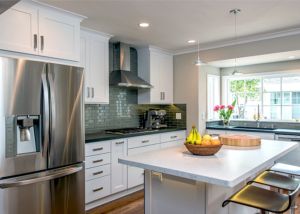Whether you’re looking to refresh your home or invest in a property, window blinds can do a lot to improve the overall look and functionality of a room. However, you should take some time to consider style, function and insulation before choosing your ideal blinds.
Depending on your mounting choice, installation may require tools such as a stepladder, pencil, tape measure, drill and screwdriver. Visit https://www.customblindsandshadesky.com/ to learn more.

The light filtering capabilities of blinds can transform workspaces, encouraging heightened focus and productivity. With a variety of fabric options and tilting slats, you can direct light in specific areas of the room or create a softly diffused glow. For the most precise control over light, choose blinds with anti-glare coatings to reduce harsh reflections and glare. Lighter colored blinds reflect light, while darker colors absorb it.
Many shades, such as roller and Roman blinds, are designed to block out sunlight while diffusing light for a warm and cozy ambiance. Additionally, some cellular shades (also known as honeycomb blinds) are made from soft fabrics that offer excellent light control and privacy benefits. They fold up along crisp pleats and can be easily adjusted to the perfect position in a window.
To enhance light control, consider a roller shade with an anti-glare coating. The coated fabric will diffuse light and reduce glare, making it ideal for busy areas such as bedrooms and living rooms. For a more streamlined look, you can also find roller shades in a wide range of neutral colors.
Other shades that provide excellent light control include zebra shades, which consist of alternating sheer and opaque fabric stripes to allow you to customize the amount of natural light entering a space. These versatile blinds can be manually or motorized, and they are available in a range of fabrics, from delicate sheers to heavy blackouts.
Blinds are an efficient solution for blocking heat transfer and reducing energy costs. Some styles feature a honeycomb construction, which traps air to create an effective insulating barrier that keeps the room cooler in summer and warmer in winter.
The best blinds for energy efficiency are often crafted from sustainably-sourced wood. They can enhance the aesthetic of any room with a timeless look and contribute to the health of our planet. Additionally, you can find a wide selection of eco-conscious shades that are made from recycled plastics and other materials.
Blinds can be a more affordable option for larger windows, allowing you to maintain an open and spacious feel in the room. They can be easily cleaned with regular cleaning products and are available in a wide range of color and finish options to complement your design aesthetic.
Privacy
Blinds are composed of slats, which can be tilted open for light filtering and privacy or closed to block sunlight and prying eyes. They’re ideal for rooms like the living room, where you want easy control over the light in the space. If you want more privacy when you’re in the bedroom, you might choose to layer your windows with blackout drapery.
Curtains, on the other hand, are panels of fabric hung on a rod or track system above your window. They’re typically sold in pairs and can be pulled back and forth across your window to control the amount of light you let into the space.
If you want to limit the amount of light coming in while maintaining your privacy, consider woven wood shades. These beautiful, rustic window treatments are crafted from natural materials like bamboo, grasses, reeds and woods and come in a wide variety of colors and patterns. They’re great for rooms that don’t require the best privacy or light blockage, but will provide a beautiful accent to your home.
Both blinds and curtains can be used for privacy, but if you’re looking for the best blackout light control and privacy, we recommend choosing blackout roller or cellular shades. These window treatments completely block out light and sight when they’re fully closed, ensuring that no one can peer into your space at night.
To keep your blinds looking their best, we recommend scheduling regular maintenance services. These professional cleanings will help remove dust and dirt buildup that can diminish your window treatment’s performance over time.
Whichever type of window treatment you choose for your home, it’s important to take the time to think about how it will perform in your space. The right style and materials will make all the difference in how well your windows function, and will also impact the aesthetic of your space. We’re here to help you find the perfect blinds for your home, so schedule a consultation at our showroom in San Antonio or Boerne! We’ll help you select the best options to suit your privacy and light control needs.
Energy Efficiency
A typical home loses up to 30% of its heating and cooling energy through the windows. With window treatments that block the sun’s heat, however, your home will stay much more comfortable without increasing your energy bills. At Lorraine’s, we offer a wide variety of shades that reduce solar heat gain through your windows. The lower the solar heat gain coefficient (SHGC), the better. Our energy-efficient blinds and curtains can even help save you money on utility bills by reducing your dependence on HVAC systems.
Draperies, like our beautiful selection of Graber draperies, can reduce the amount of heat that passes through windows by acting as a thermal barrier. When drawn during the winter, they can keep your interior home warm while preventing drafts from entering your living space. They can also help reduce energy consumption by minimizing the amount of conditioned air that escapes through your window during the daytime. During the summer, draperies with blackout lining can help prevent heat from escaping your living space, keeping you cooler without cranking up the air conditioning.
Energy-efficient blinds are crafted with a focus on light control, privacy, and insulation. Their designs can reduce drafts, maintain consistent indoor temperatures, and protect furniture, flooring, and other interior elements from UV damage. They can also provide extra insulation to help cut your utility costs during the winter and summer.
When choosing energy-efficient blinds, look for those with a high R-value rating, which indicates how well they insulate your living space. Options with a higher R-value include cellular shades, which feature a honeycomb-within-a-honeycomb design that traps air and helps regulate interior temperatures. They can be paired with curtains to further increase the efficiency of your window treatment.
When installing your new energy-efficient blinds, be sure to follow the manufacturer’s instructions for both inside and outside mounts. This ensures that the blinds fit snugly against your window frames, limiting gaps where heat or cold can escape. A professional installer can also help ensure a perfect installation, as well as handle technical setups like motorisation and smart home integration.
Easy to Clean
Keeping your window treatments clean is important not only for aesthetic reasons but also for the health and safety of your family. Research has shown that a messy home is linked to stress, depression and even anxiety. Fortunately, cleaning your blinds doesn’t have to be an unpleasant task.
The majority of the time, all that is needed to keep your blinds looking great is a regular dusting with a cloth or brush. This will remove any built up dirt and debris from the slats. For more stubborn stains, you can use a mild solution of soap and water to wipe away the dirt build-up. If your blinds are made from a material such as wood, be careful not to soak them because the wood can warp over time.
For more difficult stains or to get rid of any mold growth, you can use a solution of diluted bleach and water. This will disinfect the surface of the slats and remove any lingering mold or mildew spores. Again, this needs to be done gently as to not damage the slats. Once the slats are clean, make sure they have plenty of time to dry before you put them back on the window.
If your blinds are very dirty, it may be necessary to remove them from the window and give them a more thorough clean. To do this, start by removing all of the slats and vacuuming them to remove any loose dirt. Then, mix a solution of warm water and a few drops of dish soap. Dip a clean sock into the solution and wring it out until it is not dripping wet. Run your sock over each slat on the blind, working from top to bottom and left to right (if your blinds are horizontal).
Finally, rinse off the slats with a damp cloth and let them air dry. For best results, leave them a few hours to dry before reinstalling them. By following these simple steps, you can keep your window treatments clean and pristine, allowing you to spend more time enjoying your home and pursuing your passions.
